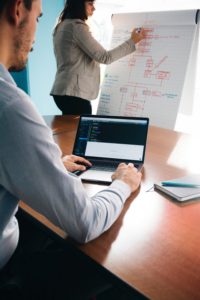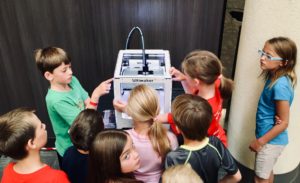In our introductory lecture for EDCI 337, Rich told us a story about how his daughter learned to help code a web application project for the Digital Scholarship Commons at the UVic Libraries. Throughout the learning process, she was able to use a lot of helpful programs and tools (such as side-by-side coding software, online lectures, and notes) as well as having two mentors by her side (one physically and one over the phone). The combination of these tools and resources led her to an efficient and rewarding learning experience (Rich McCue, 2020, EDCI 377 Topic 1).

Photo by Nicole Wolf on Unsplash
This experience showcases the effectiveness of using multimedia in a learner-centered teaching approach to achieve learning outcomes. This approach actively combines words and visuals together in a way that is “in sync with the way people learn” (Rich McCue, 2020, EDCI 377 Topic 1). Multimedia has been seen to improve learning outcomes through its accessibility when made available online and with how students can learn at their own pace (Rich McCue, 2020, EDCI 377 Topic 1). I agree with how Rich said that not all multimedia resources are created equally. Due to this, it is imperative for educators to choose their multimedia tools carefully and take into account the resources’ reliability, authenticity, and relevance to their own specific and unique group of learners.
Here are some helpful definitions I found in the readings and the lecture:
-
- Synchronous: Real-time learning. An example in education would be a real-time class in person or on zoom.
- Asynchronous: Go at your own pace or choose your own path by using the materials provided. For example, EDCI 337!
- Multimedia: more than one medium combined together to convey information or “the presentation of words and pictures” (Mayer, p. 3., 2005).
- Multimedia Learning: “learning” or “building mental representations” from words and pictures (Mayer, p.1-2., 2005).
Check out this video discussing Multimedia Learning and applying it to student memory and senses:
Historical uses of non-digital multimedia and interactive experiences influence how we use digital technologies today through how they promote critical thinking, creativity, and collaboration. Interactive learning experiences such as brainstorming, “think, pair, share,” and buzz sessions are natural opportunities for effective student assessment, flexible teaching, boosting student engagement/motivation, and enhancement of the learning process (The SHARE Team, 2018). Today, many classrooms are equipped with digital multimedia such as tablets with games/applications, classroom iPads with cameras, SMARTBoards, and lectures accompanied by interactive visuals to achieve those same opportunities as before (Mayer, p. 3., 2005).

Photo by CDC on Unsplash
Multimedia is also an excellent means of demonstrating how teaching through stories allows students to relate deeply to lessons through themes and motifs (stories can relate to a novel, lesson, current event, etc) (Juliani, 2016). Teaching students through stories that impart or reference the important material of the lesson “[increases] the potential for rich learning experiences” to occur (Juliani, 2016). There are many digital storytelling forms of multimedia that I look forward to exploring in this course such as Twine.

Photo by Agefis on Unsplash
A classic interactive learning experience that I always enjoy is group brainstorming. As simple as it may seem, collaborating with my peers on a big piece of paper really pushes me to keep thinking and continue the conversation on whatever subject is presented. It is impactful to me because I am able to discuss the topic with other people and ponder different opinions or viewpoints as we write and create a huge (and often colourful and enticing) resource with all of our thoughts.
A digital technology that I have enjoyed using in my learning experiences is Google Docs. Being able to write and edit documents in real-time alongside my peers has been very helpful in my learning journey. I have made and collaborated on pictorial and text filled study guides, scripts for speeches/presentations, research projects, and more. By being able to edit these documents on the go, view them offline, having them auto-save, and being able to access them from my smartphone has been crucial to my educational career so far.
Since “technology should complement human abilities, aid those activities for which we are poorly suited, and enhance and help develop those for which we are ideally suited,” multimedia (specifically digital multimedia) should be used purposefully in all classrooms (Mayer, p. 16., 2005). I cannot wait to learn more about this interesting topic and apply it to my teaching toolbelt!

Photo by Aw Creative on Unsplash
References
Juliani, A. (2016, March 21). The Hidden Importance of Teaching With Stories. Retrieved June 06, 2020, from http://ajjuliani.com/hidden-importance-teaching-stories/
Mayer, R. E. (2005). Introduction to Multimedia Learning. In R. E. Mayer (Author), The Cambridge Handbook of Multimedia Learning (pp. 1-16). New York, NY: University of Cambridge.
McCue, Rich. (2020). EDCI 337 Topic 1 – Introduction to Interactive & Multimedia Learning [Video]. Retrieved from https://youtu.be/V39sIKsRpUI
The SHARE Team. (2018, April 06). 5 Examples of Interactive Teaching Styles: Resilient Educator. Retrieved June 06, 2020, from https://resilienteducator.com/classroom-resources/5-interactive-teaching-styles-2/

Leave a Reply
You must be logged in to post a comment.